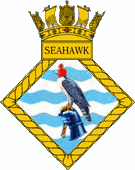Satellite and aerial maps of RNAS Culdrose with nearby locations
| Nearby locations | Km | Bearing | |
|---|---|---|---|
| | 1.3 | 328 | |
| Navy 827 , Cornwall | 1.4 | 312 | |
| Gweek , Cornwall | 1.8 | 058 | GBGWK |
| | 2.7 | 318 | |
| Weeth Farm , Cornwall | 3.0 | 298 | |
| Goonhilly Downs , Cornwall | 6.3 | 128 |
RNAS Culdrose |
1944 to present | ||
| 50° 5' 0'' N 5° 15' 0'' W | ||
| 1nm SE of Helston, Helston, Cornwall, Cornwall | ||
| ICAO: EGDR | IATA: | |
| Elevation: 268 feet | ||

Land purchased by the Admiralty in 1944 and building continued through 1945, the station was provisionally known as RNAS Helston (HMS Chough). It was however commissioned in Apr 1947 as RNAS Culdrose (HMS Seahawk). In Feb 1948 an S-51 Dragonfly (G-AJHW) was temporarily detatched here from Westlands at Yeovil to re-supply the lighthouse keepers on the Wolf Rock due to continuing bad weather. 
In Apr 1949, the Naval Jet Evaluation and Training Unit (702 Squadron) was the first to receive jets and the first to fly them from Culdrose. In Oct 1951, Airborne Early Warning radar trials were undertaken using Skyraiders supplied under MDAP, from 778 Squadron. By Jun 1953, the SAR Flight had retired its Sea Otters for the WS-51 Dragonfly and during Jul 1953 the base code CW was changed to CU. 
Three major changes for Culdrose occured in the 1950s. By end of 1953, the emphasis had shifted to Anti-Submarine Warfare and by Jul 1958, the base focussed mainly on rotary wing operations. RNAS St.Merryn had closed towards the end of 1958, making Culdrose the heart of naval aviation activity in Cornwall. 
Culdrose welcomed the School of Aircraft Handling from RNAS Lee-on-Solent, then saw the introduction of the Whirlwind HAS.7 in Jun 1959, the Wessex HAS.1 in Jun 1960, the Wasp HAS.1 in Jun 1963 and the Wessex HAS.3 in Jan 1967. Then between 1969 and 1971, major building works took place, allowing multiple runway operation by helicopters, resiting hangars and closing the old road across the east end of the base. 
Following the successful introduction to RN service of the Sea King HAS.1, the Sea King Foreign Training Unit was established between 1972 and 1976. Between May and October 1972 the 4 resident Commando squadrons had moved with their Wessex HU.5 to RNAS Yeovilton. In 1973, the commitment for 365x24 SAR cover began, which was extended in Apr 1975 to keep at least one aircraft permanently available for SAR. 
Further new types were successfully introduced to service. The Gazelle HT.2 from Mar 1974, the Sea King HAS.2 from Sep 1976 and the Jetsream T.2 replacing 750 Squadron's Sea Prince T.1 from Oct 1978. During Aug 1979 Culdrose SAR aircraft flew concentrated missions during the Fastnet yacht race, rescuing 75 crew from many competitor craft over a period of 3 days. 
The Sea King HAS.5 was introduced in 1980 and by mid 1982, many of Culdrose Sea King's has been committed to the Falkland Islands, campaign. Largely as a result of the Falklands experience, the Sea King AEW.2A appeared with 849 Squadron in Nov 1984. New Jetstream T.3s arrived for 750 Squadron in Apr 1986 and work on the original control tower began, the new one opening in May 1989. 
Culdrose provided 826 Squadron Sea Kings during the 1991 Gulf War, which located over 30% of all moored mines discovered. The RAF Sea King Training Unit departed to RAF St.Mawgan in 1993, eventually becoming 203(R) Squadron. That year also saw NATO commitment from Culdrose units in Bosnia and made contributions to the UN blockade of Montenegro. 
With the formation of the Defence Helicopter Flying School in April 1997, 705 Squadron retired its Gazelle HT.1 and left for RAF Shawbury. The record of service introduction continued and the Merlin IFTU, 700(M) Squadron, formed in Dec 1998. In Jun 2011, the Avenger T.1 arrived with 750 NAS to replace the Jetstream, for Observer Training in tomorrows smaller Royal Navy. 
With the increasing of numbers of Merlin HM Mk1 at Culdrose, 824 NAS re-commissioned in 2000 to train ab-initio and convertee aircrew and maintainers in the purpose-built Merlin training Facility(MTF). In 2001, 814 NAS was re-activated with 4 Merlins in the traditional home of front-line Fleet Air Arm ASW squadrons, Bravo Southsite. Shortly afterwards 820 NAS re-commissioned, again with 4 airframes, a significant reduction in numbers from the 1980s, when 12 airframes was the norm.
Flights designed to deploy worldwide on Type 23 frigates (and eventually Type 45 frigates) were formed from elements of 824 NAS. HMS Lancaster saw the first Merlin flight to go to sea, deploying to the South Atlantic and South America in 2002. HMS Monmouth (2002), Westminster (2004) and Northumberland (2005) followed, with deployments ranging from the Caribbean to South East Asia and the Mediterranean. All flights transferred to 829 NAS on its re-commissioning on 21 October 2004, resuming its former role of the 1980s. 
The Rescue Sea King HU.5 which had been a feature of the Cornish airspace since 4 Sep1974, ceased SAR operations on 31 Dec 2015. 771 NAS decommissioned on 23 Mar and the last Sea King HU.5 left the base on 11 Apr 2016. The association with the Sea King continues with the ASaC.7 still operated by 849 NAS, until the Crowsnest Merlin is introduced to service. 
Operations at RNAS Culdrose |
| Dates | Operation | |
|---|---|---|
| 11-jun-21 | 13-jun-21 | G7 Summit 2021 |
Airshows at RNAS Culdrose |
| Dates | Airshow |
|---|---|
| 28-jul-16 | Culdrose Air Day 2016 |
| 24-jul-13 | Culdrose Air Day 2013 |
